ข่าวสารตลาด & มุมมองเชิงลึก
ก้าวนำตลาดด้วยมุมมองเชิงลึกจากผู้เชี่ยวชาญ ข่าวสาร และการวิเคราะห์ทางเทคนิค เพื่อเป็นแนวทางในการตัดสินใจซื้อขายของคุณ.

Most traders understand EA portfolio balance through the lens of traditional risk management — controlling position sizes, diversifying currency pairs, or limiting exposure per trade.
But in automated trading, balance is about deliberately constructing a portfolio where different strategies complement each other, measuring their collective performance, and actively managing the mix based on those measurements.
The goal is to create a “book” of EAs that can help diversify performance over time, even when individual strategies hit rough patches.
A diversified mix of EAs across timeframes and assets can, in some cases, reduce reliance on any single strategy. This approach reduces dependency on any single EA’s performance, smooths your overall equity curve, and builds resilience across changing market conditions.
It’s about running the right mix, identifying gaps in your coverage, and viewing your automated trading operation as an integrated whole rather than a collection of independent systems.
Basic Evaluation Metrics – Your Start Point
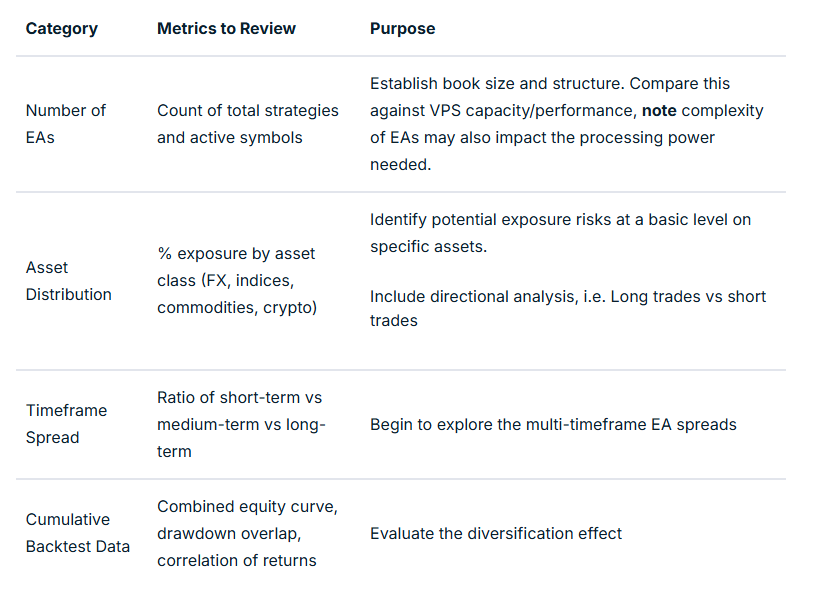
Temporal (timeframe) Balancing
When combined, a timeframe balance (even on the same model and instrument) can help flatten equity swings.
For example, a losing phase in a fast-acting M15 EA can often coincide with a profitable run in an H4 trend model.
Combining this with some market regime and sessional analysis can be beneficial.
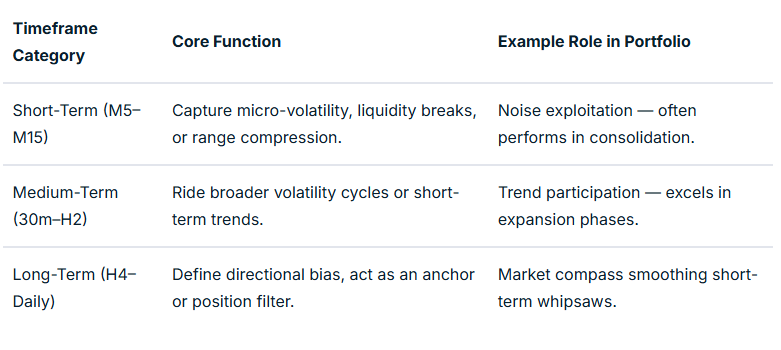
Asset Balance: Managing Systemic Correlation Risk
Running five different EAs on USDJPY might feel diversified if each uses different entry logic, even though they share the same systemic market driver.
But in an EA context, correlation measurement is not necessarily between prices, but between EA returns (equity changes) relating to specific strategies in specific market conditions.
Two EAs on the same symbol might use completely different logic and thus have near-zero correlation.
Conversely, two EAs on a different symbol may feel as though they should offer some balance, but if highly correlated in specific market conditions may not achieve your balancing aim.
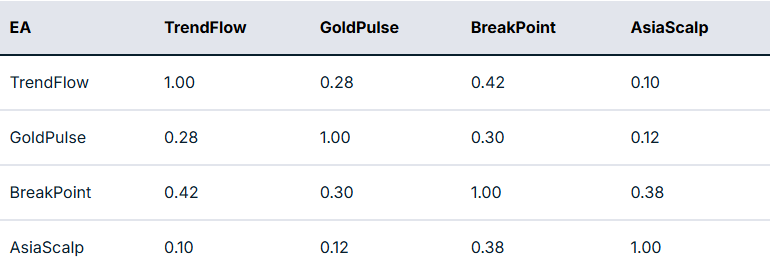
In practical terms, the next step is to take this measurement and map it to potential actionable interventions.
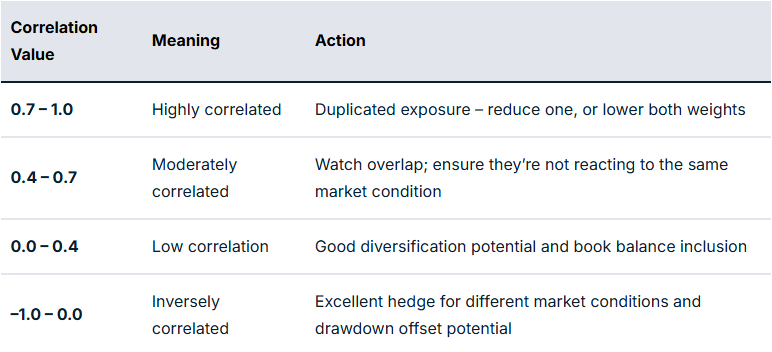
For example, if you have a EURUSD Trend EA and a GBPUSD Breakout EA with a correlation of 0.85, they are behaving like twins in performance related to specific market circumstances. And so you may want to limit exposure to some degree if you are finding that there are many relationships like this.
However, if your gold mean reversion EA correlates 0.25 compared to the rest of your book, this may offer some balance through reducing portfolio drawdown overlap.
Directional and Sentiment Balance
Markets are commonly described as risk-on or risk-off. This bias at any particular time is very likely to impact EA performance, dependent on how well balanced you are to deal with each scenario.
You may have heard the old market cliché of “up the staircase and down the elevator shaft” to describe how prices may move in alternative directions. It does appear that optimisation for each direction, rather than EAs that trade long and short, may offer better outcomes as two separate EAs rather than one catch-all.
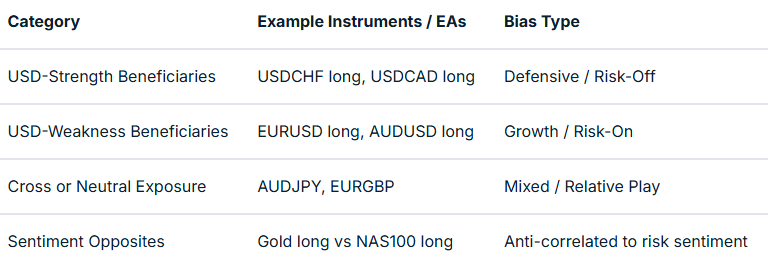
Market Regime and Volatility Balance
Trend and volatility states can have a profound impact on price action, whether as part of a discretionary or EA trading system. Much of this has a direct relationship to time of day, including the nature of individual sessions.
We have a market regime filter that incorporates trend and volatility factors in many EAs to account for this. This can be mapped and tested on a backtest and in a live environment to give evidence of strategy suitability for specific market conditions.
For example, mean reversion strategies may work well in the Asian session but less so in strongly trending markets and the higher volatility of the early part of the US session.
As part of balancing, you are asking questions as to whether you actually have EA strategies suited to different market regimes in place, or are you using these together to optimise book performance?
The table below summarises such an approach of regime vs market mapping:
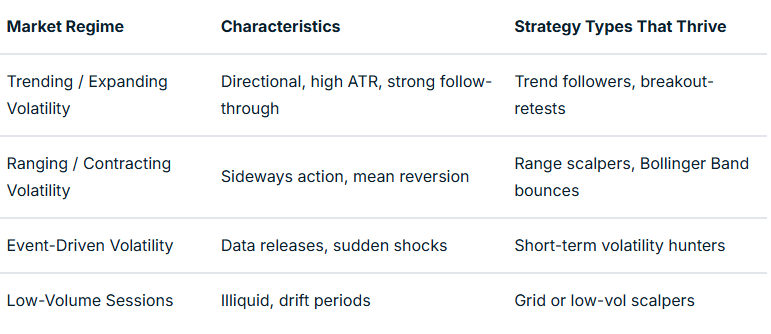
Multi-Level Analysis: From Composition to Interaction
Once your book is structured, the challenge is to turn it into something workable. An additional layer of refinement that turns theory and measurement into something meaningful in action is where any difference will be made.
This “closing the circle” is based on evidence and a true understanding of how your EAs are behaving together. It is the step that takes you to the point where automation can begin to move to the next level.
Mapping relationships with robust and detailed performance evaluation will take time to provide evidence that these are actually making a difference in meeting balancing aims.
To really excel, you should have systems in place that allow ongoing evaluation of the approaches you are using and advise of refinements that may improve things over time.
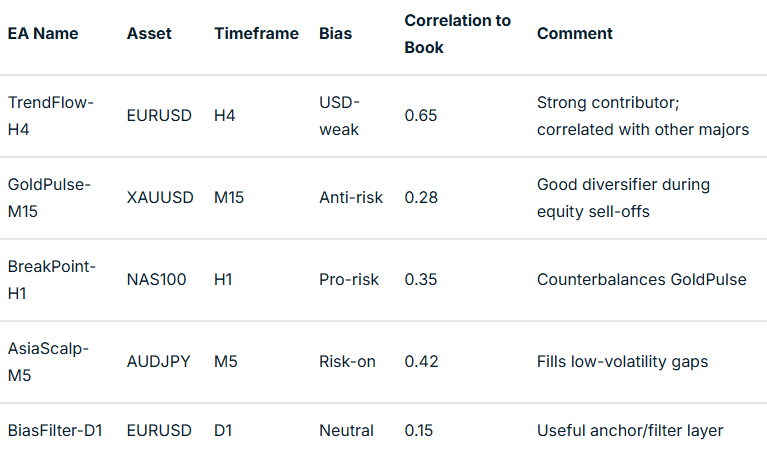
What Next? – Implementing Balance in Practice
Theory must ultimately translate into an executable EA book. A plan of action with landmarks to show progress and maintain motivation is crucial in this approach.
Defining classification tags, setting risk weights, and building monitoring dashboards are all worth consideration.
Advanced EA traders could also consider a supervisory ‘Sentinel’ EA, or ‘mothership’ approach, to enable or disable EAs dynamically based on underlying market metrics and external information integrated into EA coding decision-making.
Final Thoughts
A balanced EA portfolio is not generated by accident; it is well-thought-out, evidence-based and a continuously developing architecture. It is designed to offer improved risk management across your EA portfolio and improved trading outcomes.
Your process begins with mapping your existing strategies by number, asset, and timeframe, then expands into analysing correlations, directional bias, and volatility regimes.
When you reach the stage where one EA’s drawdown is another’s opportunity, you are no longer simply trading models but managing a system of EA systems. To finish, ask yourself the question, “Could this approach contribute to improved outcomes over time?”. If your answer is “yes,” then your mission is clear.
If you are interested in learning more about adding EAs to your trading toolbox, join the new GO EA Programme (coming soon) by contacting [email protected].


There is an apparent enthusiasm among traders nowadays to add indicators to charts that resemble modern art more than market analysis. RSI, MACD, moving averages, stochastic oscillators, Bollinger Bands, volume profiles, and so many more. While these tools do have their place in some strategies, many traders forget the fundamental truth: price is the source, everything else is a reaction.Learning to read price as a narrative, showing a sequence of events that reveals the intentions and psychology of both buyers and sellers, can offer the trader a level of understanding that no single or even multiple indicators can give.
Indicators Are the Supporting Act — Not the Main Show
Don’t take from the opening that I think for one moment that Indicators are inherently bad. They can be helpful when used correctly as a way to offer some confluence to what the current price may be suggesting.But by design, most indicators are lagging. They take price and/or volume data and apply mathematical formulas to summarise or smooth the past.Moving Averages tell you where the price has been over the period of the MA setting. RSI shows whether the recent move has been relatively strong, even if it doesn’t tell you why. MACD illustrates the relationship between two moving averages and whether it's changing, but not necessarily market intent.Indicators are descriptive, not predictive. They are great at confirming bias but may not produce desired outcomes when used as your primary decision-making tool.
Price Action is a Language
Every candlestick is a snapshot of a battle occurring between buyers and sellers over a fixed point in current time. The shape and size of each bar contain a message.A large bullish candle (close near the high) indicates strong buyer control during that bar.A long wick above the body shows attempted movement upward but failure to hold — in other words, a rejection at higher prices.A doji (small body, long wicks) suggests indecision — neither side in control.And of course, the reverse is the case for a bearish candle.These are not random. They reflect the psychology of where market participants are now and can imply a degree of confidence, hesitation, exhaustion, or even reversal pressure.
Key takeaway:
There could be merit in starting each trading session by scanning the last 5–10 candles on your timeframe and asking: Who was in control? Are they still in control? And is there evidence that this may continue or be changing on THIS candle?”These simple questions can dramatically shift your perspective from reaction to anticipation.
What is Market Structure?
While individual candles can show immediate intent, structure reveals progression.A trend is never a continued straight line; market structure is the pattern of swing highs and swing lows that form the underlying skeleton of a trend.An uptrend forms higher highs (HH) and higher lows (HL).A downtrend forms lower highs (LH) and lower lows (LL).A range is where highs and lows are roughly equal, showing balance between buyers and sellers.Structure tells you where traders are likely to place orders and whether a trend may continue.There may be stops placed below swing lows, creating potential support. There may be profit targets at prior highs, creating potential resistance.Breakout or breakdown movement may be triggered if there is a break of these structural key levels, e.g., a break of a previous swing high may suggest continuation.
Key takeaway:
Try to map out the most recent swing highs/lows on your chart. Ask the question: Are we building a structure to continue, or is there a potential pause point where the market may decide to shift direction? And how should this impact my decision to enter a trade or stay in an open trade?This framing, based on current market structure, helps you align with momentum rather than chase it.
Volume: The Emotion in the Story
While price tells you what is happening, volume gives a sense of how much conviction is behind it. Volume adds depth and credibility to the story of price. Although there are those who would be reluctant to use tick volume with Forex and CFD trading, there is still potential legitimacy in testing this in your trading. As it is leading, not lagging, volume with price (arguably) acts as an important market gauge. High volume on a breakout = genuine interest with evidence of market convictionLow volume breakout = potential trap. Lack of participation means the move may fail.Effort vs. Result = if price moves very little despite high volume, it suggests absorption — large opposing orders are sitting there.
Volume as a Visual Lie Detector?
Sometimes price action looks bullish, but volume says otherwise. For example, A bullish engulfing candle that forms with lower-than-average volume is often a false signal. A reversal candle that forms with a volume spike often suggests a strong shift in sentiment.To use this practically, consider a volume average line to highlight when it may be time to act (or time not to).
How to Practice Your Trading Story Creation
Through the key fundamental principles covered above, you can start training how to create a market story.
Daily Market Story Exercise:
- Strip off all indicators apart from volume!
- Look at the last 10–20 candles.
- Say out loud or write the story you see in front of you — e.g., “Price was rising but slowed near resistance. After a rejection candle, sellers stepped in with conviction as evidenced by the candle formation and volume. Now it’s testing the prior support zone…”
Do this each day, and you’ll build the ability to trade based on understanding of what market psychology is telling you rather than just guesswork.
When to Use Indicators — and When to Walk Away
As stated before, indicators aren't useless but can play an important part in confirming or disputing your market story. They work well when they confirm what price action already suggests, smooth out trends or help define zones, and help filter conditions (e.g., only trade long above 200 EMA).If you find yourself staring at indicator crossovers or waiting for an RSI line to tick over 30 without looking at price, you are reading the footnotes, not the full plot.Use indicators in the background, not the foreground of your decision-making.
Summary
Price is not just data, it’s market dialogue. It’s the collective voice of every trading participant in the market NOW. It demonstrates emotion, logic, and intention. When you learn to read the price like a story, you start anticipating rather than reacting. You reduce overtrading with a focus on price action that is compelling, not just suggestive. And arguably, your interaction with the market becomes clearer, simpler, and potentially far more powerful.
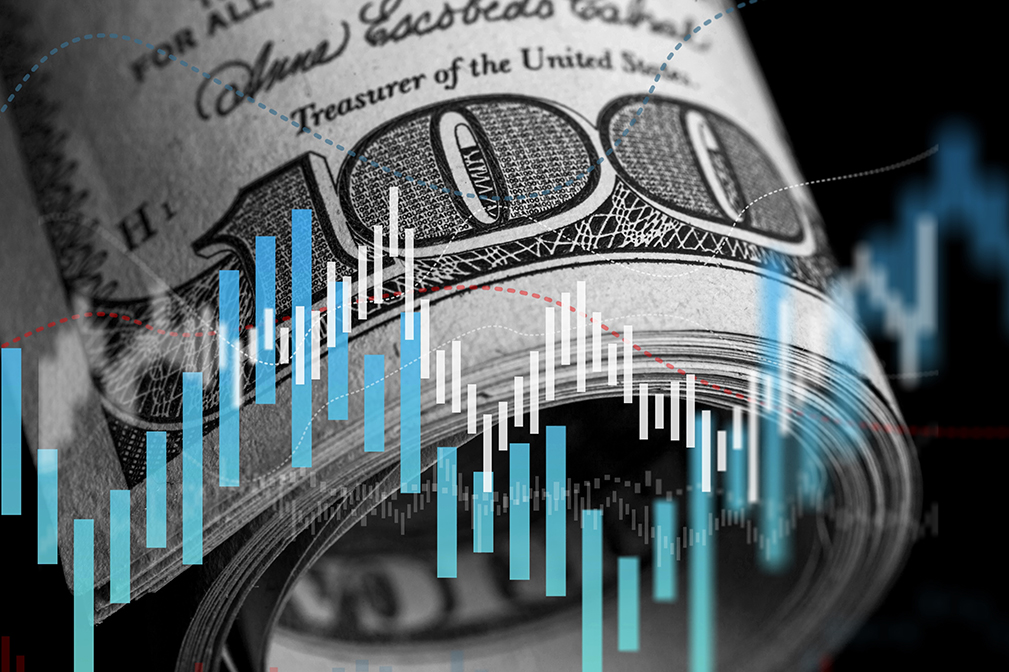

1. Inflation Uncertainty
While recent data has shown core inflation moderating, core PCE is on track to average below target at just 1.6% annualised over the past three months.Federal Reserve Chair Jerome Powell made clear that concerns about future inflation, especially from tariffs, remain top of mind.“If you just look backwards at the data, that’s what you would say… but we have to be forward-looking,” Powell said. “We expect a meaningful amount of inflation to arrive in the coming months, and we have to take that into account.”While the economy remains strong enough to buy time, policymakers are closely monitoring how tariff-related costs evolve before shifting policy. Powell also stated that without these forward-looking risks, rates would likely already be closer to the neutral rate, which is a full 100 basis points from current levels.
2. The Unemployment Rate anchor
Powell repeatedly cited the 4.2% unemployment rate during the press conference, mentioning it six times as the primary reason for keeping rates in restrictive territory. At this level, employment is ahead of the neutral rate.“The U.S. economy is in solid shape… job creation is at a healthy level,” Powell added that real wages are rising and participation remains relatively strong. He did, however, acknowledge that uncertainty around tariffs remains a constraint on future employment intentions.If not for a decline in labour force participation in May, the unemployment rate would already be closer to 4.6%. Couple this with the continuing jobless claims ticking up and hiring rates subdued, risks are building around labour market softening.
3. Autumn Meetings are Live
While avoiding firm forward guidance, Powell hinted at a timeline:“It could come quickly. It could not come quickly… We feel like the right thing to do is to be where we are… and just learn more.”This suggests the Fed will remain on hold through the July meeting, using the summer to assess incoming data, particularly whether tariffs meaningfully push inflation higher. If those effects prove limited and unemployment begins to rise, the stage could be set for a rate cut in September.


The US has entered the Israel-Iran war. However, despite an initial 4 per cent surge on the open, oil has settled where it has been since the conflict began in early June — around US$72 to US$75 a barrel.Trump claims the attacks from the US on Iranian nuclear facilities over the weekend are a very short, very tactical, one-off. This is something his base can get behind — some really big conservative players do not want a long-contracted war that sucks the US into external disputes.Whether this will be the case or not is up for debate, but there is a precedent from Trump's first presidency that we can look to. Iran had attacked several American bases in 2019, as well as attacking Saudi Arabia's most important oil refinery with Iranian drones. There wasn't a huge amount of damage; it was more a symbolic movement and display of capabilities by Iran.Initially, Trump didn't react — it took pressure from Gulf allies like the UAE and Israel for him to respond, which saw him order the assassination of the head of the Iranian Defence Force, Qasem Soleimani. This led to an Iranian response of ‘lots of noise’ and ‘cage rattling’, but minimal real action events, just a few drone attacks. Trump is betting on the same reaction now.If Iran follows the same patterns from the previous engagement, the geopolitical side of this is already at its peak.As of now, Iran is not going after or destroying major Gulf energy capabilities. Nor have there been any disruptions to the shipping traffic through the Strait of Hormuz. In fact, apart from a posturing vote to block the Strait, Iran has not made any indication that it is going to disrupt oil in any way that would lead to price surges.Additionally, despite the U.S. military equipment buildup in the region being its highest since the Iraq war, critical Iranian energy infrastructure is running largely unscathed.This all suggests that the geopolitics and the physical and futures oil markets remain disconnected. Oil will spike on news rumours, but the actual impacts in the physical realm to this point remain low. Of course, this could change in future. But, for now, the risk of seeing oil move to US$100 a barrel is still a minority case rather than the majority.
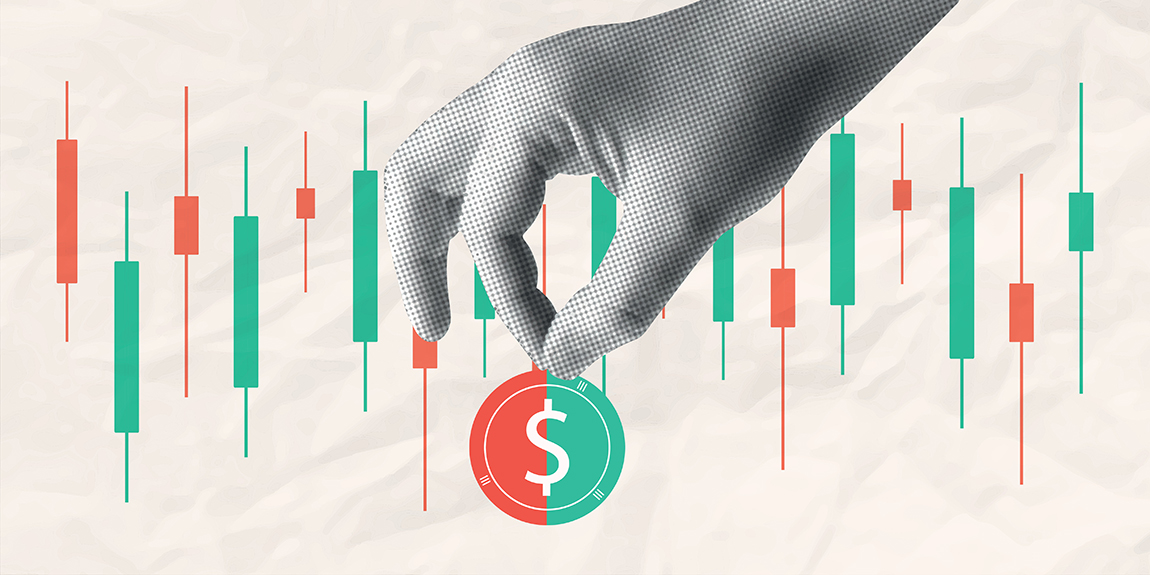

Position management is one of the most overlooked skills in trading. The shiny new entry setups seem to proliferate our social media channels, while position management receives little airplay.Yet it can be what separates a trader who rides price moves with clarity on when to take action, from one who repeatedly watches their unrealised profits simply vanish.In this article, we break down both sides of position management — scaling in and scaling out — and explore practical ways you can blend these tactics into your existing strategy.
What Are ‘Scaling In’ and ‘Scaling Out’?
Scaling in means opening your full intended position size in planned stages instead of all at once when you first see a potential set-up. This allows you to test your idea with smaller risk first, then add size as the trade proves itself. Done well, it’s like gradually moving with the “market breath” as it shows evidence of a continued move.Scaling out means taking profits off in “chunks” as the price reaches certain levels — locking in some realised profit gains rather than waiting for an all-or-nothing technical exit. Through banking gains progressively, you also reduce risk, leaving less at the mercy of the next Truth Social post or sentiment-changing event.
Why Do This?
At first glance, this may sound unnecessarily messy. Why not just get in and get out — keep it clean?Real markets rarely move in a straight line, even with the strongest of trends. Trends invariably develop in waves, and reversals can often happen quickly, irrespective of instrument or timeframe.
Benefits of Scaling In
- Risk Control: By starting small, you’re not overcommitted too early. If the setup fails, your loss is smaller.
- Confirmation: Adding when a trend continues to be confirmed helps align your exposure with demonstrated market momentum. Price action is king, and this should dictate what we do and when we do it.
- Confidence Booster: Committing in smaller steps feels less intimidating, particularly when combined with a trail or scaling-out strategy.
Benefits of Scaling Out
- Lock in Cash Flow: Taking some profit at logical points locks away real money while giving the rest of your position room to run, helping overcome any feeling of fear of missing out – FOMO — as discussed in a recent article.
- Reduces Pressure: We have all seen a big open position profit swing back. Donating your profit back to the market this way places you in a high-stress situation. Further trading decision-making may be less sharp as a result. Such stress is far less if you’ve already banked part of your profit, and you gain confidence from a good decision.
- Flexibility: You’re not forced to perfectly time the absolute high or low. You capture the ‘meat’ of the move in stages. The time when a trade is most likely not to continue in a desired direction is right at the very start of a trend, where we often see false breakouts, or near the end, where momentum is starting to drop. Why not take advantage of this?
Errors with scaling (how you can mess it up)
The potential benefits of scaling in and out are clear; however, you can still run into issues if you misuse them.Here are three scenarios where many traders may see it fail:
- Averaging Down: Adding more to losing positions, hoping to ‘get back to break-even,’ is a classic but not uncommon trap. Scaling in should always be based on the underlying concept, adding to price move strength, never to weakness.
- Random Additions: Adding size just because a trade is profitable, without clear levels or criteria for action, often backfires. It can lead to scaling at the wrong time or overdoing the next scale in lot size, as overconfidence takes over.
- No Clear Plan: Many traders who believe in the scaling out concept have every intention to do so, but in the absence of clear criteria. Having an unambiguous, specific price action-based approach is vital. Without such guidance, trading logic may be easily replaced by emotional decisions.
Like all parts of your trading, the best results are usually obtained through articulating this part of your strategy within your written plan. Constantly adjusting scale-in or scale-out points mid-trade causes overthinking and inconsistency. The whole point is to reduce second-guessing with what to do and when to do it, not add more.
Examples of ‘Scaling In’ Approaches
Example 1: Break-and-Retest approach
Scenario: A resistance level breaks decisively.Action: Enter 50% of your planned size at the breakout.Confirm: If price pulls back and holds above the broken level, add the remaining 50% on a bullish confirmation candle.Why: You get initial exposure early, but most size goes in once you have more evidence that the breakout is valid.
Example 2: Trend Building approach
Scenario: In a clear trend with identifiable pullbacks.Action: Enter the initial lot size on the setup confirmation. After a retracement pullback, add more on a breach of the recent pre-retracement swing high. Why: Rather than dumping all your capital at the first sign of pause (and there are signals which may indicate this is likely a pause rather than a reversal), you are riding the trend leg by leg, using market structure to guide your positioning.
Examples of ‘Scaling Out’ Approaches
Example 1: Predefined Profit Milestones based on risk
Example: Plan to take off 50% at 1R (one unit of risk) or an ATR multiple and trail the rest over breakevenWhy: You secure a profit cushion while letting the remaining position run for higher returns.
Example 2: Approaching Known Levels
Example: Scaling out just before major resistance levels for longs (or support levels for shorts).Why: Price often reacts to previous price consolidation levels. Taking partial profit nearby locks in gains before potential reversals. Market participants observe these levels, and there may be limit orders that may cap the likelihood of a move through the next key level.
Example 3: Weakening Momentum
Example: If you see a slowing on momentum indicators (e.g., smaller histogram bars or signal line histogram cross) or reversal candle pattern on a smaller timeframe, close a portion rather than the whole trade.Why: If you’re wrong about the trend ending, the remainder might still offer further upside benefit.
Tips for Mastering Scaling
Here are three underpinning principles to help you master scaling:
- Always plan scale points before you enter a trade — not on the fly.
- Never add to losing trades. Scale in only as confirmation builds and criteria are met.
- Journal your trading: Compare the results of trades with and without scaling to see its impact. Make this an ongoing exercise to offer some evidence to refine your initial system.
Final Thoughts
Scaling in and scaling out are not the holy grail, but if acted on well, are sharp tools for traders who want to manage trades that are in tune with the underlying market.Handled with care, they help you ride trends more smoothly, protect open position profit, and reduce the mental anguish every trader can face when the market moves unpredictably in a fully open position.The bottom line is you don’t need to catch every pip or point, just enough to make sure that you give yourself a better chance to grow your account consistently than you may be doing now.


Have you ever stared at your charts, perfectly certain your setup is valid, then right when you are ready to press the entry button, you freeze, tweak the setup, or abandon it altogether?If so, then you have probably experienced what I call the ‘Imposter Trader Syndrome’.Irrespective of trading experience or the evidence-based nature of your trading plan, it can show up as a nagging self-doubt that makes you second-guess your method, ignore your tested plan, or jump in or out of trades for reasons you’d never put in your strategy rules.The outcome is that you move away from what you had planned to do. It eats away at both your consistency and confidence, and consequently impacts negatively on your account balance.
What Is Imposter Trader Syndrome?
Many of you will recognise the term ‘imposter syndrome’ from professional life, which is used to describe a sinking feeling that you are somehow not good enough or that you’ll be “found out” as a fraud — despite all evidence to the contrary.In a trading context, it can show up in two dangerous ways:
- Doubting your analysis and execution in both entry and exit decision-making
- Assuming good results are not attributed to knowledge and skill, but rather luck or the market gods smiling on you for a while.
Carrying these around with you may fuel indecision, constant tweaking, or abandoning your plan altogether, moving you away from consistency and confidence.
Why Does This Happen?
During many coaching hours spent with traders, there are a few common themes considered root causes of imposter trading syndrome:
1. Comparing Yourself to Others:
It is very easy to look at another trader’s highlight reel on social media (read ego-driven rambling) and assume they never hesitate or lose. You don’t see their losing trades because that is not what it is about for them. Rather, the only losing trades you will often see are just your own.
2. Recency Bias
If your last few trades were losers, it is tempting to conclude you have “lost your touch,” ignoring the fact that any system can have drawdowns. Consecutive losses within a profitable year are normal, and challenging market conditions were perhaps contributory to more difficult trading conditions. This focus on the last few rather than the big picture can result in behaviours that move away from established systems.
3. The Chase For Perfection
Many traders want a system that gives zero losses and a 100% win rate. Here is a reality check -- it does NOT exist. It is an impossible standard that can paralyse rational thinking. You may begin to fear making ‘a mistake' (any loss at all) so much that you make no decision at all. Logically, a tested system that produces positive results over time will have losses. The only mistake you can make is to move away from that system. The ability to follow it consistently, irrespective of the outcome of a single trade, should be perceived as a success.
4. Lack of Trust in Your Data
Traders often think they have a solid plan in place, but when it lacks unambiguity, hasn’t been stress-tested properly, or has only traded a handful of times in a live environment, it is difficult to develop trust in it. We know that confidence in your system is probably the number one contributor to the ability to exercise execution discipline. Unless you address this, there is a good chance that doubts will creep into your decisions more and more.
What Imposter Trader Syndrome Looks Like
Closing trades too early: Your trade has gone in your desired direction, but you don’t trust the trade to reach your planned target, so you bank profit “just in case”, only to see it hit your original profit target without you in the market.Skipping valid setups: You see the signal, but the voice says, “I have lost on the last two trades, what if I’m wrong again?” So you let it go without you and watch the price fly exactly to the set-up point you had originally planned for.Over-tweaking your plan: Constantly adding new filters, changing indicators, or modifying rules mid-week, or in the middle of a session, to “fix” something that wasn’t actually broken. I have lost count of the number of times I have seen charts with lines and colours that would look more at home in your local art gallery rather than as part of a well-thought-out trading system. Too many times, many of the things on charts either replicate another indicator, or even worse, there are things on there that the trader does not know what it is telling them at all.Revenge trading: This point is a little more ambiguous than the others, but I feel it is important to include it. Wanting to get your money back to where it was before, or trying to prove that you are a good trader when a couple of trades have gone against you, can also be a sign of imposter trader syndrome. Some suggest it can also be a form of self-sabotage, where one loss feels like proof you aren’t good enough, so you overtrade to prove yourself right.
Why Confidence Matters as Much as Analysis
More often than not, it is a failure in execution rather than a failure in system that is the cause of imposter trading syndrome. Analysis can mean very little without the confidence to follow through on it religiously. Even a flawless system fails if the trader hesitates, exits too soon, or overrides it out of fear.A consistent trading edge only works when you apply it consistently, and that takes trust in yourself as a trader and trust in your system.
The image below summarises the difference. Which trader would you like to be?
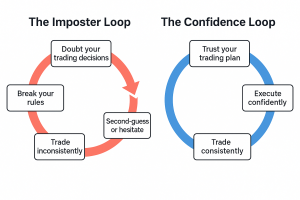
The Imposter vs Confidence Trading loop
Six Ways to Beat Imposter Trader Syndrome
1. Own it!
Until you admit that there is something amiss with what you are doing, you will never do anything to make it better. Move past the excuses and placing blame, and accept that you can do things that are in your control to move to the next level.
2. Prove It to Yourself with Data
Backtest your setup, find someone to help with this if you need to, then forward test with small positions. Keep a journal tracking whether you stuck to the plan you have invested time and effort in creating. Test out “what if” analysis of the trades you know moved away from the plan to see what would have happened if you exercised discipline in the action. Your confidence in your system will grow instantly when you see that following your rules beats not doing so.
3. Focus on Process Over Outcome
Reward yourself mentally for following the plan, not just for winning. Success in trading is usually a result of consistency in action. A well-executed loss is still a win for you in the journey towards becoming a confident, disciplined trader.
4. Use Pre-Trade and Post-Trade Checklists
A simple “Did I follow my entry rules? Did I place my stop and target correctly?” routine keeps you anchored to the process. There are lots of examples of such checklists available online, and it is a common theme covered on the education webinars we run at GO Markets.
5. Trade Smaller When Doubt is High
When moving toward where you need to be, conviction is key. Reducing size while rebuilding your trading self-esteem takes the pressure off. Better small, consistent execution than large emotional missteps in your recovery from perhaps months or even years of not achieving what you can.
6. Limit Noise
Avoid bouncing between ten different trading ‘gurus’ and strategies. Pick the lane that best resonates with your trading style and flexibility, and commit long enough to learning and refining your best-fitting system to give it a chance to see real results.
Summary
Feeling like a ‘trading imposter' is more common than most would care to admit. Unless you begin to own that it could be you, then it is likely to slowly erode your consistency and trading self-esteem. Note the signs and symptoms and commit to doing the things that build confidence in your system as well as yourself. Remember, you are not competing with other traders’ highlights, nor some of the outlandish claims of outrageous results that some may make. You are aiming to become the best trader you can be — build your own sustainable results with a system backed by evidence that fits your trading style, personal trading objectives, and financial situation.


Ignoring corporate actions is a common pitfall many CFD traders fall into. Longing or shorting the underlying share is rooted in technical and fundamental analysis, and simple dividend payouts or buybacks feel unimportant to the trading strategy.However, even though you’re trading an instrument whose value is determined by the movement of an underlying asset, rather than the asset itself, these events can still impact your account balance.It is vital to stay informed of the corporate actions of the underlying share and have a plan for the way you position trades and the length of time you consider holding a position.
Company Dividends
A dividend is the distribution of a portion of a company’s profits to its shareholders. It’s one of the primary ways companies reward investors and signals that the company is in good financial health.
Why Companies Do It:
- To share profits with investors
- To signal stability or maturity
- To attract dividend-focused shareholders
Example:
Woolworths declares a $1 dividend. If you’re long 100 CFDs, you get a $100 credit. If short, you lose $100 on the ex-div date.
CFD Implications:
Long Position: You receive a credit into your account on the ex-dividend date Short Position: Your account is debited the equivalent value.
Market Reaction:
Share prices typically drop by the dividend amount on the ex-div date on open.
Stock Splits and Reverse Splits
A stock split increases the number of shares and reduces the price per share, retaining the existing total market value e.g., your shares may become half the price but you will have double the holding. A reverse split (or consolidation) does the opposite so reducing the number of shares so increasing the price per share.
Why Companies Do It:
- Stock splits make high-priced shares more affordable and attractive to retail investors and increase day-to-day interest.
- Reverse splits are less common but may often be used to lift a stock’s price to improve the perceived positive image of the company.
Example:
Tesla executed a 5-for-1 split in 2020. Holding 100 CFDs became 500 CFDs at 1/5th the original price.
CFD Implications:
Your CFD position is automatically adjusted to reflect the new ratio. Total value remains unchanged.
Market Reaction:
Splits can signal growth confidence and attract traders, often leading to short-term rallies. Reverse splits may be seen as a red flag and lead to selling pressure.
Rights Issue
A rights issue allows current shareholders to buy extra shares, usually at a discount to current share price to raise capital. Market response to a right issue will be dependent on the reason for this action and the overall perception as to whether it will benefit the company in the longer term.
Why Companies Do It:
- To fund growth projects, reduce debt, or raise liquidity
- A sign the company is facing financing pressure
Example:
Qantas may offer a 1-for-5 rights issue at a 20% discount to raise capital to enable the company to buy new aircraft. CFD holders do not get this entitlement.
CFD Implications:
You do not receive rights or participate in the offer. No direct adjustment is made to your CFD position.
Market Reaction:
May result in a price drop due to dilution. However, if the capital raise strengthens the company, prices may recover over time.
Share Buybacks
A company buys back its own shares from the market, reducing the total number in circulation.
Why Companies Do It:
- To return value to shareholders
- To improve metrics like earnings per share (EPS)
- To signal that management believes the stock is undervalued
Example:
BHP announces a $2 billion buyback. As shares are repurchased, the price may gradually rise due to the reduced supply of shares available to trade on the market.
CFD Implications:
There is no action on any CFD holding in the relevant company, so there is no account adjustment.
Market Reaction:
Often seen as mildly bullish, especially for undervalued companies. However, buybacks funded by debt may raise concerns.
Mergers and Acquisitions (M&A)
A merger or acquisition occurs when one company absorbs or combines with another. This may ultimately lead to a change in share structure or ticker symbol if it is approved by the shareholders of the company. There is often a situation where a proposal is presented to the company that results in an elevated share price even before any decision is made.
Why Companies Do It:
- To expand market share, gain assets, or eliminate competition
- Often part of a strategic growth plan
Example:
If Company A merges with Company B and issues 1 new share for every 2 held, your 200 CFDs in A would convert into 100 CFDs in the new entity.
CFD Implications:
Your existing CFD position is converted into the new merged entity (if applicable) using the agreed share ratio.
Market Reaction:
Target companies often rally when takeover bids emerge, while acquirers may see mixed reactions — depending on perceived value or cost of the deal.
Trading Halts
A pause in trading that is imposed by the exchange usually often due to a pending news release from the company about a new, unexpected corporate action or less commonly some regulatory concerns pending investigation.
Why Companies May Be Halted:
- Awaiting a price-sensitive announcement
- Pending merger, legal issue, or earnings release
Example:
If a US biotech stock CFD is halted for an FDA ruling, you’ll remain in your position until the underlying reopens.
CFD Implications:
If the stock is halted, your CFD is also paused. You cannot open or close positions until trading resumes (there will often be a second release informing when the stock is likely to reopen for trading).
Market Reaction:
Trading halts usually precede large price moves — often gaps and reopens — so significant gains or losses may be the result.
Summary
Just because you’re trading Share CFDs doesn’t mean you are insulated from corporate actions. In fact, understanding their timing (although many are unpredictable) and the possible impact of your holding is essential for planning trades and managing actual and potential account value adjustments.It is prudent to have access to an economic calendar as part of your routine and ensure you check out earnings and ex-dividend dates of any stock CFD you hold or are considering for an entry.Whether it’s a dividend or a major structural event like a merger, these changes can and will shift market sentiment towards the underlying stock. Make sure you stay aware of what is happening and what might happen next. The GO Market support team will always be there to assist with any questions you have before or after any corporate action.

